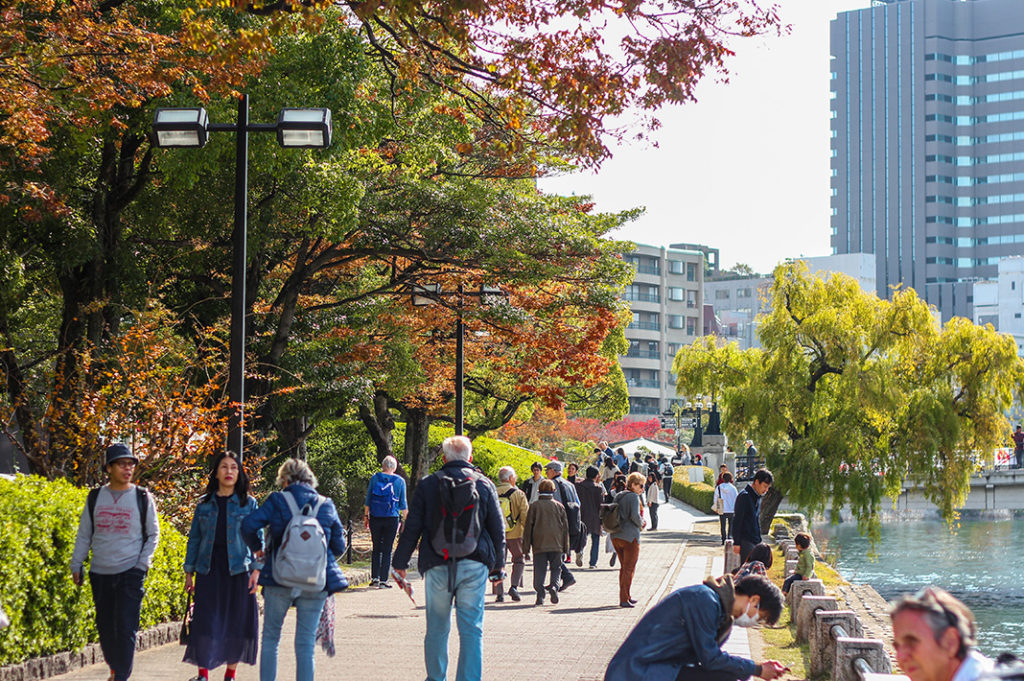Amongst the different regional varieties of the savory pancake-like concoction known as okonomiyaki, connoisseurs frequently tout Hiroshima’s version as one of the best. In other regions, the cabbage, batter, vegetables and meat that form okonomiyaki get mixed together prior to cooking. In Hiroshima, however, each ingredient is separate and piled one on top of another. As a result, each bite allows you to move layer by layer. You can savor each ingredient before they combine into something even more delicious in your mouth. From the Atomic Bomb Dome in the Peace Memorial Park to a high-tech exhibition at Hiroshima Castle, Hiroshima affords a similar experience. While much of Japan touts itself as a mixture of the modern and traditional, Hiroshima preserves each layer of its history. They remain connected but also separate. Only by traveling through the different layers, do you get a sense of the city as a whole.
Peace Memorial Park
Like many travelers visiting Hiroshima, our first stop was the Peace Memorial Park. With survivors still living, and nuclear proliferation an ongoing problem, any attempt to wrestle with the tragedy of the nuclear bomb faces difficult questions. How do we come to terms with suffering? Who has the right to speak about shared trauma? What lessons does the past teach? The Memorial Park that runs through the center of the city, offers several perspectives on these problems.

The Atomic Bomb Dome was almost directly beneath the bomb when it exploded on August 6th, 1945. Unlike nearby structures, it retained much of its shape. Today, it survives mostly unchanged and in 1996 UNESCO designated it as a World Heritage Site. It stands as a solemn reminder of past destruction, but, for some, its survival also marks it as a possible symbol of resilience. Walking from the Atomic Bomb Dome towards the Peace Museum, visitors encounter several other memorials. The Peace Flame offers hope of a future without nuclear weapons, while the Memorial Cenotaph, which bears the names of the victims killed in the bombing, serves as a reminder of everything lost.
Along with the Atomic Bomb Dome, the Hiroshima Peace Memorial Museum is the most poignant and harrowing view of the past. During our visit, the museum was undergoing renovations. However, a small exhibition in one of the building’s wings still provided an overview of the museum’s collection. The museum offers survivor testimonies, visual recreations, and excavated artefacts. Visitors should be respectful and mindful of their behavior.
Leaving the Park
The park surrounding the memorial is a beautifully landscaped public space. Moving a little away from the memorial, you can find plenty of opportunities to grab some local fare. In the early dusk, several picnickers lined the banks of the river, while evening cruises drifted through the fallen cherry blossoms on the water’s surface.
As we left the park and moved towards the hotel, Hiroshima grew denser and busier. Streetcars bustled through the streets and diners wandered the street looking for a good place to grab dinner. Long before World War II, the city was a center of commerce. Today it still retains something of the hectic atmosphere it must have had at the turn of the 20th century. During this time, the city was one of the major trade ports, and housed a number of factories, military installations and even some of the country’s first English schools. This history comes into view as you traverse the lively streets that criss-cross the heart of the city.
Hiroshima Castle Meets teamLab
After dropping our bags at the hostel, we decided to walk over to Hiroshima Castle. Though rebuilt along with the rest of the city, the castle belongs to yet another period. Preceding the development of the city itself, the castle was built at the end of the 16th century. Over time, the city sprung up around the castle, and the fortress served as home for several local rulers.
As it turned out, the castle was hosting an outdoor exhibition by the famed teamLab artistic collective. In recent years, the group has made a name for themselves around Japan with their high-tech projection art. The most famous examples of their work exist in a pair of Tokyo galleries. Their frequently tactile and interactive work shifts with time and moves across surfaces. The castle exhibition was no different. A forest of colorful orbs lined the castle gardens while digital carps–a popular symbol of the city–swam along the city walls.
Once again, the different levels of history preserved within the space of Hiroshima came to mind. The artistic spectacle didn’t disturb the old castle, it was layered on top. It was a reminder that to respect history, it must be understood both within the context of the present and on its own terms. As we left the castle and enjoyed the first of two okonomiyaki dinners, I tried to take the lesson to heart.
Name: Hiroshima
Address: 1-6-34 Kokutaiji, Naka-ku, Hiroshima-shi, 730-8586
URL: http://www.city.hiroshima.lg.jp/english/
Post by Japan Journeys.